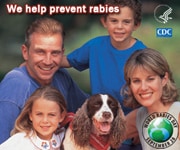How can you prevent rabies in people?

Understanding your rabies risk and knowing what to do after contact with animals can save lives. Any mammal can get rabies, but the most commonly affected animals in the United States are raccoons, skunks, bats, and foxes — so the best way to avoid rabies in the U.S. is to stay away from wildlife. Leave all wildlife alone, including injured animals. If you find an injured animal, don’t touch it; contact local authorities for assistance.
Rabies in dogs is still common in many countries outside the United States, so find out if rabies is present in dogs or wildlife at your destination before international travel.
Because pets can get rabies from wildlife and then could spread it to humans, preventing rabies in pets is also an important step in preventing human rabies cases.
If you do come into contact with a rabid animal, rabies in humans is 100% preventable through prompt appropriate medical care. If you are bitten, scratched, or unsure, talk to a healthcare provider about whether you need PEP.
Preventing rabies around the globe
Although dog rabies is no longer a problem in the United States, the most important global source of rabies in humans is from uncontrolled rabies in dogs. Children are often at greatest risk from rabies. They are more likely to be bitten by dogs, and are also more likely to be severely exposed through multiple bites in high-risk sites on the body. Severe exposures make it more difficult to prevent rabies unless access to good medical care is immediately available.
This major source of rabies in humans can be eliminated through ensuring adequate animal vaccination and control, educating those at risk, and enhancing access of those bitten to appropriate medical care. The annual World Rabies Day campaign, first observed in 2007, brings together researchers and partners to accomplish these goals by mobilizing awareness and resources in support of human rabies prevention and animal rabies control around the world.

